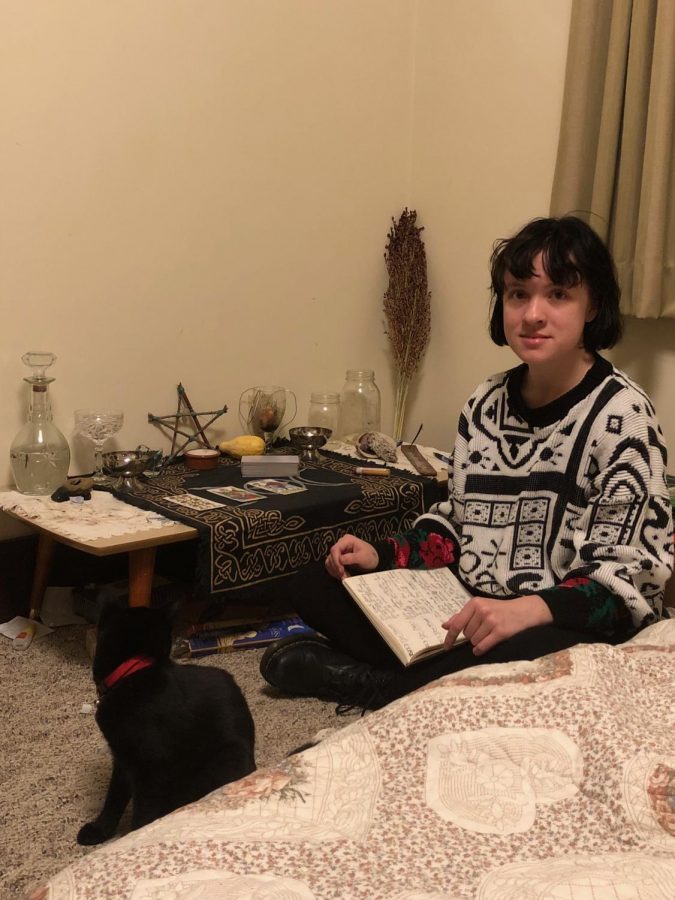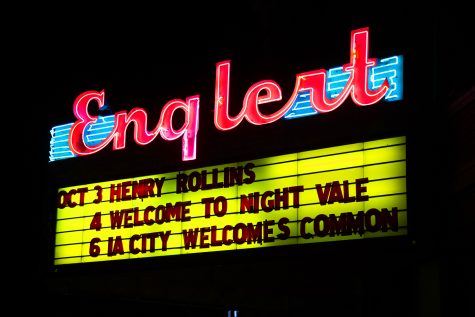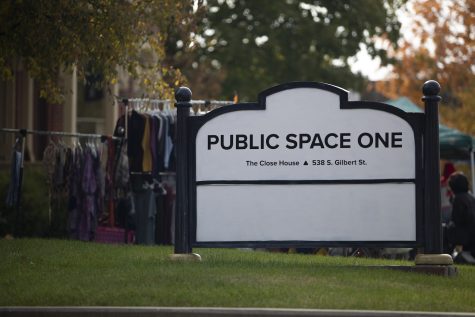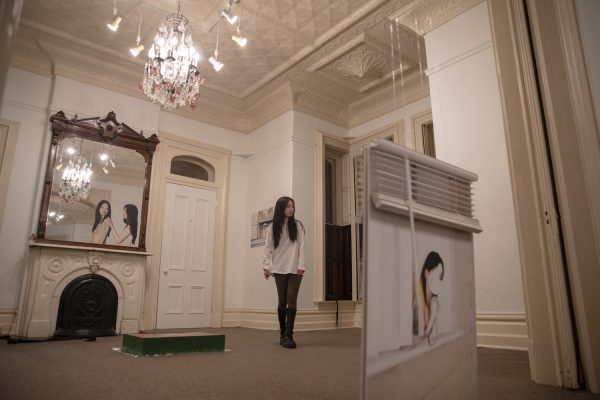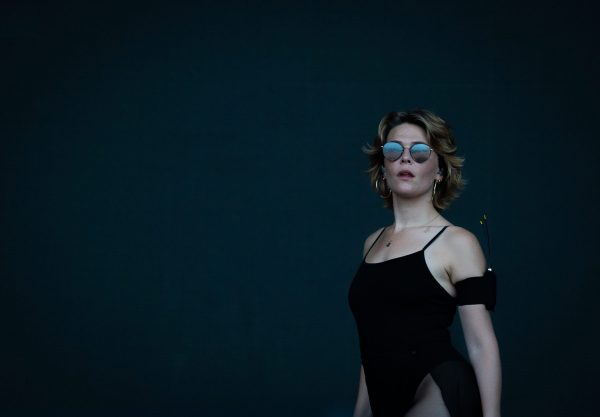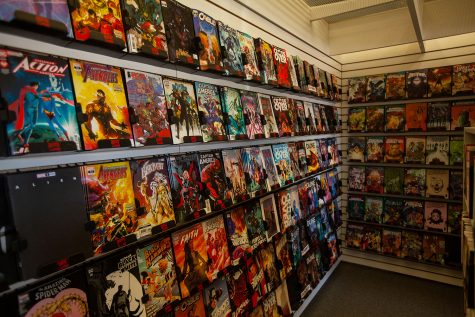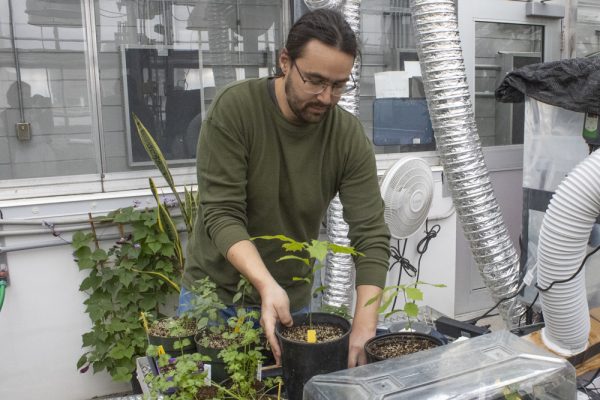Arts and crafts of the corridor; witches practice within Iowa City
Witch, Wiccan, or metaphysical practitioner, the Iowa City area is home to a host of beliefs and rites.
October 24, 2018
Black cat in tow, UI junior Molly Bagnall walked into her bedroom, the scent of incense and myrrh thick in the air. Here, an ancient practice collides with the modern age, and, across from posters of Judy Garland and Bernie Sanders lies a small altar.
The altar was essentially a coffee table upon which sat the most interesting collection of crystal, salt, twigs, incense, a Book of Shadows, and a glass containing rainwater. The items represented elements for a Wiccan’s practice – rainwater for water, salt for earth, and burning incense for fire. The twigs, gathered from College Green Park, and crystals were tied together to create a standing pentagram. Bagnall noted the five points stand for each element: air, fire, water, earth, and spirit.
Bagnall is a practicing Wiccan, a religion based on a spiritual connection to the Earth and its cycles. It focuses on honoring the planet and giving back to the universe. The Earth and its seasons are very influential when it comes to Wiccan spells, in which Wicca will use resources and words to manifest their intents. Natural sources and supplies can be harnessed in Wiccan spells and in witchcraft.
“It’s something I’d been interested in and feeling; I always felt connected to the Earth,” Bagnall said. “I grew up Christian, but felt like I should be honoring the Earth more. After looking into Wicca, I was like, ‘Yes.’ ”
Bagnall’s Book of Shadows provides grounding for her to pay tribute to the Earth, document it, and reflect upon her trial and error. It holds her spells, former and future, and everything she’s learned about the principles of Wicca, crystals, colors, and Wiccan holidays. The upcoming harvest holiday, Samhain (Halloween), is arguably the most important holiday for Wiccans and witches alike, as Wiccans believe the veil between the spirit world and our world dissipates, allowing for communication with the dead, beloved or not.
The 20-year-old plans on celebrating by using earthly ingredients in making bread, combining her Wiccan honoring of the Earth and witchcraft in casting spells on the bread for prosperity and wellness for herself and those who eat it.
“I’m kind of famous for bringing bread to ragers,” Bagnall said with a giggle.
While similar, Wicca and the practice of witchcraft are different. While both include spell work and revolve around the elements, witchcraft is not necessarily a religious practice.
UI sophomore Maggie Timboe is a practicing witch. The secular kitchen witch does not identify as Wiccan but said she believes things in nature have special properties that can be harnessed to influence one’s life. While she may not follow Wiccan practices, she does participate in Wiccan holidays such as Samhain, as its traditions align with the natural world; most holidays fall on equinoxes or solstices and follow the traditional harvest cycles.
Much like Bagnall, Timboe will cook using common ingredients that witches believe to have additional abilities, such as cinnamon or basil, to create foods blessed with spells in order to connect with others. Cooking provides an easy way of casting spells that is enjoyable for witch and guest alike.
“Being a kitchen witch allows me to take certain ingredients associated with Pagan holidays or magical properties and turn them into a recipe — that’s my strength,” Timboe said.
Aside from carrying apple seeds for luck, Timboe’s favorite and most convenient spell to cast is a moon-water spell. A witch who practices by the moon cycles, the 20-year-old said she believes astrology and the moon’s position and sign is powerful in spell casting. She will set a jar of water outside under the moon overnight with crystals inside, to harvest energy from the moon and the crystals.
Timboe said she will then drink the water throughout the week to physically manifest her intent. She doesn’t have a specific name for this spell, but it is important to note that no two witch’s spells are exactly the same; the craft is different for everyone. Each witch will make what she will of her belief, craft, and practice.
“I used to be worried I was going to do something wrong or that I needed to know everything before I started,” Timboe said. “That’s not true; it’s about you and how you choose to use your power and impact the world around you.”
According to Lisa Lister’s book on the matter, Witch, a basic rule for Wiccans and witches alike is this: do no harm, or in more specific language, “An Ye Harm None, Do What Ye Will.”
This essentially means that a Wiccan or witch may do what she pleases, as long as she is not manipulating her neighbors in a hurtful way. Wiccans believe the universe has ways of repaying bad deeds, as well as good deeds; call it karma, the Threefold Law, or just plain old dumb luck, actions have consequences.
Historically, witches, actual or perceived, have been targeted as a way to eradicate superstition and “magical activity” in the midst of churches of England in the 17th century.
UI Lecturer Kathleen Kamerick speaks on the oppression of women perceived as witches in her article “Shaping Superstition in Late Medieval England.” Kamerick poses that many things were seen as superstitious “magical activity,” even perhaps Christian practices such as making charms.
In conducting any “magical activity” such as charm-making or divination, one had to consider intent in late-medieval England, according to Kamerick’s research. Charms were to be made with Christian intent, without curiosity, and divination was only acceptable if the sight was of natural occurrences of God’s creation, without sight into a self-path, or into human will.
Any practice unaligned with the status-quo of Christianity was considered idolatrous, and deserving of a punishment that varied in severity. Kamerick found that most salvation from trials came in the form of compurgators, or character witnesses, that attested to the good, Christian quality of the person in court. Those targeted as practitioners of witchcraft, whether actual or perceived, were often individuals that were disabled, poor, or sick. More often, they were persons in opposition to popular political decisions of the church.
In new-wave feminism, witches are more outspoken than ever, whether that be in politics or religion. Underground practices and religions such as witchcraft and Wicca have been thrust into the mainstream, but perhaps not for the best.
Different types of witchcraft, and the idea of spiritually powerful women, have been present in cultures all over the world, according to Witch. Be it Brujas in Hispanic cultures, Shaman women, Romani Shuvihani witches, Hoodoo witchcraft in African-American and Native cultures, or Celtic witches, the idea of women possessing an inherent power and connection to the spiritual world for healing and other works is a global concept.
In each Halloween season, there is an avalanche of all things supernatural into the mainstream. With it comes witch-kits, crystal trends, and costumes galore that, to an actual witch, may seem inappropriate. Witchcraft is a serious, poignant practice that is open to interpretation and each person that approaches it, but it is also a subject that entails study and research. Not merely a salt lamp, sage, and black eyeliner is needed for connection to the Earth and to oneself. Both Wiccans and witches take issue with trends such as this.
For Bagnall and Timboe, the aesthetics of witchcraft are capitalized on in the Halloween season. Being a witch is seen as temporarily cool, creating frowns for real witches. It seems to either connote a trendy, quirky style, or devil worship. Both are false, said Timboe. Witchcraft is different for each witch, yes, and anyone who would like to try it should be able to, she said, but in a serious, mature way that includes dedication and research. There are some things that Timboe would try that Bagnall wouldn’t and vice versa. As long as one is using the tools with intention, there is no real definition of a witch.
At the same time, a witch must be careful not to take too much from other cultures so as not to appropriate other practices, Bagnall said. Materials in witchcraft have properties that transcend culture, but some practices are sacred to certain cultures. One practice, the practice of devil worship, has no part in witchcraft, contrary to popular belief. The devil does not exist in Wicca or witchcraft; no deity does. There are gods and goddesses, yes, but for the observing, modern, religious Wiccan, the connection is primarily with the Earth, not with any deity. Gods and goddesses are used to serve as figures to represent an idea or concept to focus on, rather than an actual celestial being.
The god and goddess are used to invoke the elements, as is the same with other materials such as broomcorn, natural water (rainwater), natural materials from the seasons, and candles. All of these items can be found in or made from nature, but sometimes it is necessary to gain a bigger supply, especially for continuous casting of spells. Timboe generally gets her supply from nature, while Bagnall goes to a local store, Om, in downtown Iowa City.
Om Gifts for Body & Soul contains supplies for all spiritual practices, from Christianity to Buddhism to Wicca. Figures of Mother Mary are positioned right next to Saraswati, the Hindu goddess of fine art, music, speech, and knowledge. Om stocks supplies for Wicca and witchcraft, such as candles, tarot, and books. The owner, Jeet Saini, has been in business for 25 years, and has gained a wide understanding of spirituality.
“Not everyone follows one thought,” Saini said. “We have so many resources now, and everyone has a developed mind. Cultures overlap, and people find others interesting; people like to explore.”
Just a quick drive away in Cedar Rapids, Illuminations serves as another option for a Wiccan or witch with an empty altar. The owner, Stephanie Ryan is much like Saini, a dabbler.
“Depending on how I feel, I might go meditate for Zen or cast a spell,” Ryan said. “I may even go sit in the Catholic Church for the sacredness.”
Illuminations is filled with tarot, crystals, herbs, books— anything one could possibly need, for whichever practice. Illuminations opened in 2012, but Ryan purchased the business on Halloween 2016. Off to the right of the bright, open room is a back hallway that provides as an escape for healing in these practices. Customers are encouraged to get massages, readings, holistic energy work, guidance, or even practice yoga in the various rooms provided.
As the Samhain season comes to a head, Wiccans and witches alike will honor the Earth in practice and craft. Observers should feel free to join in, but with genuine interest and respect.



